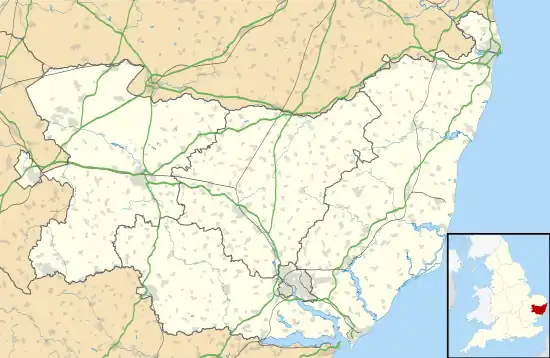Blaxhall Common
Blaxhall Common is a nature reserve in the parish of Blaxhall in the East Suffolk District of Suffolk. The reserve is owned by Blaxhall Parish Council and managed by Suffolk Wildlife Trust.[2] It is designated a 45.9-hectare (113-acre) biological Site of Special Scientific Interest as Blaxhall Heath.[1][3] It is part of the Sandlings Special Protection Area under the European Union Directive on the Conservation of Wild Birds,[4] and of the Suffolk Coast and Heaths Area of Outstanding Natural Beauty.[5] A Bronze Age bowl barrow is a Scheduled Monument.[6]
| Site of Special Scientific Interest | |
 | |
 Blaxhall Heath shown within Suffolk | |
| Location | Suffolk |
|---|---|
| Grid reference | TM 380 565[1] |
| Coordinates | 52.155°N 1.478°E |
| Interest | Biological |
| Area | 45.9 hectares (0.46 km2; 0.18 sq mi)[1] |
| Notification | 1987[1] |
| Location map | Magic Map |
Location
The site is located on the Suffolk Sandlings, an area of sandy soil and glacial geology stretching along the Suffolk coast from Ipswich to Southwold.[7] The traditional land cover was lowland dry heathland, but much of this landscape has been destroyed with isolated areas, such as at Blaxhall, surviving.[7][8][9] The site is bordered to three sides by the Sandlings Forest SSSI.[3]
Blaxhall Common is around 1 mile (1.6 km) east of Blaxhall and 2 miles (3.2 km) south-west of Snape on the B1069 road between Snape and Tunstall. It is 5 miles (8.0 km) south-west of Leiston and 8 miles (13 km) north-east of Woodbridge. It falls on the edge of the Suffolk Coast and Heaths Area of Outstanding Natural Beauty (AONB).
Plant and wildlife
The heath is mainly heathers with a mosaic of heather and acidic grassland habitats.[8] The Silver-studded blue butterfly was reintroduced at the site in 2007.[10] Bird species present include nightjar, woodlark and tree pipit with reptiles such as the common lizard and adder Vipera berus established on the site. There are also colonies of solitary bees and ant-lions.[2][8][11]
The heath is managed through seasonal cutting of vegetation, especially invasive species, in order to maintain a variety of habitats.[2] Hebridean sheep and Exmoor ponies have also been introduced at the site in order to assist management.[10] A car park is maintained by the Suffolk Wildlife Trust to allow access to the reserve.
Archaeology
An ancient boundary bank forms the southern edge of the site and is well preserved[8] and the northern area of the heath is the site of a Bronze Age bowl barrow standing around 1.2 metres (3.9 ft) tall.[12] The barrow is a scheduled ancient monument. The common includes a number of Iron Age sites as well as a wide World War II anti-glider ditch. This provides habitats for solitary bees and lizards.[8]
References
- "Designated Sites View: Blaxhall Heath". Sites of Special Scientific Interest. Natural England. Retrieved 23 May 2017.
- "Blaxhall Common". Suffolk Wildlife Trust. Retrieved 23 May 2017.
- "Map of Blaxhall Heath". Sites of Special Scientific Interest. Natural England. Retrieved 23 May 2017.
- "Designated Sites View: Sandlings". Special Protection Area. Natural England. Retrieved 23 May 2017.
- "Suffolk Coast & Heaths Area of Outstanding Natural Beauty Management Plan 2013–2018" (PDF). Suffolk Coast & Heaths AONB. p. 76. Archived from the original (PDF) on 2016-08-15. Retrieved 6 August 2016.
- Historic England. "Monument No. 391314". Research records (formerly PastScape). Retrieved 23 May 2017.
- Suffolk's lovely sandlings, Suffolk, East Anglian Daily Times. Retrieved 2013-01-28
- Blaxhall Heath Archived 2015-05-05 at the Wayback Machine, SSSI citation, Natural England. Retrieved 2013-01-28.
- Sandlings heaths and forests Archived April 13, 2012, at the Wayback Machine, Suffolk Wildlife Trust. Retrieved 2013-01-28.
- Suffolk Wildlife Trust's silver-studded blue butterfly , BBC news website, 2010-04-22. Retrieved 2013-01-28.
- Blaxhall Heath - Unit 1
- Historic England. "Bowl barrow on Blaxhall Common (1008485)". National Heritage List for England. Retrieved 2013-01-28.